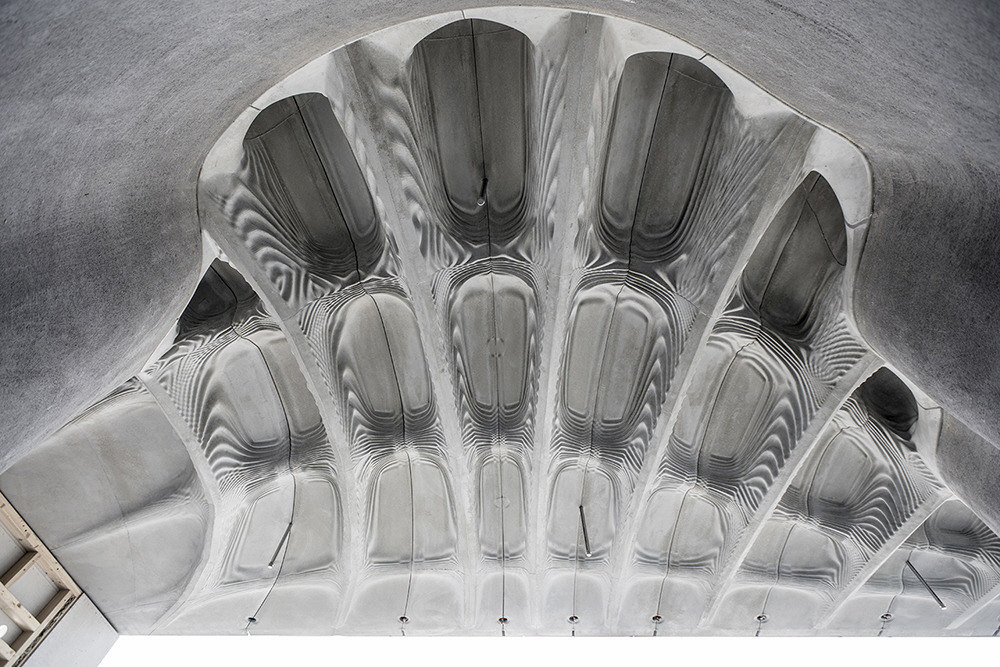 voxeljet AG 3D-printed the highly complex formwork for the DFAB House (digitally fabricated house) research project in the NEST (Next Evolution in Sustainable Building Technologies) of the EMPA (Swiss Federal Laboratories for Materials Testing and Research). This is a 78 m2 lightweight concrete slab as a statically optimised and functionally integrated floor slab with an unusually complex shape. 3D printing with the "powder-binding-jetting" process has once again proven its worth here.
voxeljet AG 3D-printed the highly complex formwork for the DFAB House (digitally fabricated house) research project in the NEST (Next Evolution in Sustainable Building Technologies) of the EMPA (Swiss Federal Laboratories for Materials Testing and Research). This is a 78 m2 lightweight concrete slab as a statically optimised and functionally integrated floor slab with an unusually complex shape. 3D printing with the "powder-binding-jetting" process has once again proven its worth here.
At NEST near Zurich, voxeljet AG was once again able to demonstrate how 3D printing is particularly suitable for creating highly complex formwork. For the DFAB House project (Digitally Fabricated House), a research project of the ETH Zurich in the context of the National Centre of Competence in Research Digital Fabrication (NCCR DFAB), 136 formwork elements were created using the powder binder jetting process. Printing was carried out using the Furan Direct Binding process. A layering process in which sand with an average grain size of 140 micrometres is used to create the formwork.
3D printing saves time, material and costs
The intelligent ceiling is one of the core elements of the DFAB House, which is being designed, planned and built on EMPA's NEST using digital processes by ETH Zurich's Digital Building Technologies (DBT) professorship headed by Prof. Dr. Benjamin Dillenburger. The formwork system for this large-scale project was developed by members of the DBT professorship. The aim of the project was to demonstrate how 3D printing, based on optimised CAD data, can save material. Ceilings require much more concrete than columns - up to 80% of the total weight of a building can be caused by ceilings. The savings potential is correspondingly large. The goal was achieved: in the DFAB House, the ceiling is only as strong at each point as is statically necessary. Thus, more than 60% of concrete could be saved compared to conventional constructions. 3D printing using the powder binder jetting process was the optimal solution for these highly complex and three-dimensionally curved concrete elements in the DFAB House. "Smart Slab" is intended to help the construction industry to build more material-efficiently and compactly in the future, as it already integrates additional functions such as lamp sockets, drill holes or openings for sprinkler systems. The cavities and open spaces of the slab structure also offer space for further lines and pipes.
Flexible and cost-effective formwork method for complex shapes
In this demanding project, there was a lot to be said for 3D printing the individual formwork elements. Project manager Dr Mania Aghaei Meibodi names the main advantages of this method as follows: "Thanks to a digital model, adjustments can be made easily at any time and without additional costs. If a three-dimensional shape changes, the 3D data and thus the 3D print can be easily adjusted. In this way, we were able to adapt the geometry of the ceiling precisely to the 3D scan of the load-bearing wall. Furthermore, very complex geometries can be mapped that were not feasible before."
With the VX4000 from voxeljet - the world's largest 3D printing system for sand moulds - formwork elements of 4.00 x 2.00 x 1.00 m can be printed, each of which can withstand a concrete pressure of 100 kN/m² after appropriate finishing. The 136 elements printed by voxeljet have a total volume of more than 6,000 litres. The largest element comprised approx. 70 litres. The 3D-printed partial elements were prefabricated at voxeljet and then infiltrated with polyester resin on the formwork surface by ETH Zurich, coated with a release agent and assembled into formwork for the seven-metre-long ceiling elements. Before the concrete was actually poured, a fibre-reinforced shotcrete was applied in a thin layer. Last but not least, a laser-cut wooden formwork was placed for the struts and the concrete was poured. After stripping the formwork, the prefabricated parts could be transported directly to the construction site and assembled there.
In summary: 3D printing in the powder binder jetting process saves time, material and costs. The use of 3D-printed formwork will revolutionise concrete construction in a wide variety of applications (formwork, formwork skins, facades, etc.) in the long term and give companies a decisive market advantage.


















































































